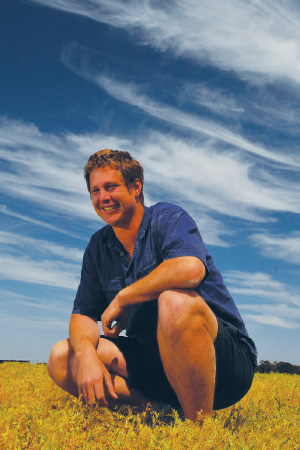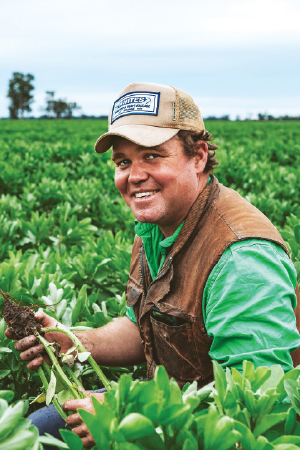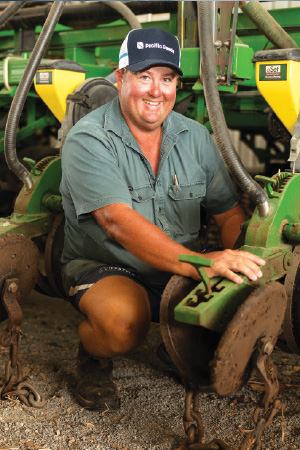Each year, GroundCover™ follows a group of growers across Australia as they manage their cropping season. In this fourth instalment for 2024, they report on how the season is shaping up. For most, the season is looking good with healthy crops pointing to what could be a healthy harvest
Western Australia
 Mitch Miolini says this season has been warmer, with heavier dews compared to last year. Photo: Evan Collis
Mitch Miolini says this season has been warmer, with heavier dews compared to last year. Photo: Evan Collis
Mitch and Emma Miolini farm with Mitch’s brother Adam, sister-in-law India and their parents Robert and Maxine. The Miolini family are fourth-generation farmers at Mt Walker, 40 kilometres east of Narembeen in the Western Australian central wheatbelt. Their enterprise is a mixed farm comprising wheat, canola, oats, barley and lupins and 1500 head of breeding ewes.
This season’s weeds are annoying us. There are not many but we know we must control them. Our pre-emergent spray program has worked well but we look to use a range of tools. We have been continuously cropping to drive down our weed burden but are also looking to move away from imidazoline-tolerant crop types to reduce our use of this herbicide due to residue issues.
Harvest weed seed control is being considered and we are watching with interest what other growers – who have been using the systems for two to three years – have learnt. We are due to change our header over next season and may consider this tool then.
Stored moisture from summer rains enabled us to sow early and as of mid-July the cereals were tillering well and at the first to second node stage. It really helps to have the crops up and going as soon as possible to capitalise on [good] seasonal conditions. This season has been warmer, and we have had heavy dews compared to last year, which was cold and frosty. Our rainfall to mid-July has been 170 to 210 millimetres across our farms. This puts our growing season at decile three but with summer rain of 100mm (decile 9), we are sitting on an average decile five at this time of the year. Once we complete the spray program we will be top-dressing with Flexi-N nitrogen ahead of further rain fronts.
The 200 hectares we seeded to a pasture mix of oat, vetch and tillage radish has not established quite as well as we would have liked. So, we’ve decided to selectively spray out oats and grasses and then harvest what vetch seed we can and reduce our stock numbers. This decision is also in accord with the decline in market opportunities for our sheep. We have reduced our numbers by five to six hundred ewes and are fattening lambs to get them off earlier.
Victoria
 Mitch Henderson says spring will have the most bearing on how this season pans out. Photo: Brad Collis
Mitch Henderson says spring will have the most bearing on how this season pans out. Photo: Brad Collis
Mitch Henderson, with parents Craig and Pauline, brother Ben, cousin John and their families, grow wheat barley, lentils and oaten hay in Berriwillock, Wilkur and Brim in Victoria’s Mallee. They also rear poultry, using their wheat straw as bedding and then spreading it back onto paddocks as manure in a closed-loop system.
Given our subsoil moisture we’re still on track for an average year but spring will have the most bearing on our potential. We have put out enough nutrition to return an average crop, applying (compound fertiliser) Granulock Z down the chute at sowing and about 80 per cent of our nitrogen upfront.
We’ve done the other 20 per cent of nitrogen on the barley at Berriwillock, and have top-up program for wheat planned for down south (at Brim and Wilkur) if we deem it beneficial, given the extra potential for rainfall and yield there.
Our program is about four weeks behind last year. Frosty conditions put the brakes on crop development and delayed our spray program, and we had already started behind the eight ball with dry sowing conditions delaying germination.
In saying that, we knocked broadleaf weeds out of cereals, and sprayed against ryegrass through winter. In September we’ll do in-crop ‘green-on-green’ camera-assisted weed control using a Bilberry system on our Agrifac sprayer, targeting vetch in lentils. Lentils can be downgraded if foreign seed levels are too high, which incurs a penalty and cost, so it’s worth trying to eliminate it.
We started to see some lucerne flea in our legumes, so were controlling them in August. Otherwise, we’re getting marsupial pressure. They’re mowing the crop-off and laying on it in big numbers, squashing it.
Rodents, on the other hand, have been pretty good this year and we haven’t had to bait. It might be a flow-on effect of our Seed Terminator pulverising weed seeds and reducing their food source. It shows how dynamic our industry is. No two years are the same and you just learn to adapt.
South Australia
Lachie Seears farms with his wife Rebecca, children Hugh and Anneliese, and his parents, Peter and Helen, near Lucindale in south-eastern South Australia. Their 6000ha enterprise comprises cropping (wheat, canola, and broad beans), 6500 breeding ewes, and 1250 breeding cows and heifers (building towards 2000 breeders).
As expected, we finished our sowing in mid-June. The crop establishment was excellent. This year was the first time we sowed our crops dry.
Thankfully, we have not seen any slug and snail pressure, which is usually an issue.
On 31 July, all our crops looked healthy. However, they are a long way behind where they would normally be because of our late start to seeding.
One issue we have not seen this year, which is usually a constraint, is waterlogging. We recorded 190mm of rainfall for the first seven months to 31 July this year, compared to about 500mm last year.
We hope the lower rainfall will not affect yields. We only need a favourable spring, and the crops should bounce back.
In the last week of July, the crops were hit with several frosts, which slowed growth.
Our broad beans looked good. In August, a grass spray and a fungicide spray were carried out.
We expect to see most of the disease pressure during spring, so we will monitor crops, and the weather forecast and apply fungicides if required.
The wheat and canola are looking good. We are happy with their disease-free status. Weed control started in early August.
We added urea to the canola and wheat, applying it in two hits. The first stimulus includes 150 kilograms/ha of urea with ammonia sulfate. Then, in September, we plan to apply another 100kg/ha of urea.
We have a trace element program that involves applying copper, manganese, zinc and boron to the wheat.
I’m hopeful we will see a favourable spring. If the right amount of rain at the right time, the crops will respond. But if rainfall is tight, the crops will chase moisture down the soil profile as far as one metre.
New South Wales
 Andrew Freeth applied a fungicide just before canopy closure to his PBA Nanu faba beans. Photo: Kirsty Fisher
Andrew Freeth applied a fungicide just before canopy closure to his PBA Nanu faba beans. Photo: Kirsty Fisher
Andrew Freeth, his parents David and Sue, and his brother Marc grow wheat, canola, chickpeas, faba beans, 2200 Merino ewes and trade cattle near Collie and Trangie in central New South Wales.
We applied a fungicide to our faba beans in late June before canopy closure to prevent chocolate spot. We also applied one fungicide in late July to prevent Ascochyta blight in the chickpeas.
Our canola and the faba beans look a picture because both were sown at the end of April and have made the most of very good growing conditions during May and June.
The grass weeds have been sprayed, and most of the urea is on the crops. If it keeps raining, we might top up the wheat with more urea.
We have also sprayed our wheat for broadleaf weeds.
When the canola reaches the 20 per cent bloom stage, we will check the weather forecast before deciding whether to apply a fungicide to prevent Sclerotinia stem rot.
We do not usually apply a fungicide for Sclerotinia but, given the reduced cost of some products this year, we might consider one application.
We recorded 50mm of rain in May, 36mm in June and 56mm in July, which has been great because we have not seen much waterlogging damage. By the end of July, conditions looked promising.
Three frosts were forecast for the first week of August, which we expect will slow crop growth. We have not seen a big explosion of diseases yet because conditions to date have been cool.
As the weather warms, we will monitor canola, chickpeas and faba beans and the weather forecast and, if necessary, apply fungicides ahead of rainfall.
We have seen aphids and a small yellow spot in the wheat, but we are comfortable continuing to monitor it for now.
Our Merino ewe hoggets are on some IllaboA grazing wheat, and weaner cattle are on the other portion.
We will reassess the weather forecast in spring before we decide whether to continue grazing or lock up these paddocks for grain harvest. If the spring is kind, we anticipate good grain recovery.
We do not expect to have to apply any fungicide to our LRPB StealthA and LRPB RaiderA wheat because of their built-in tolerance to disease.
Old-season barley and wheat have been sold ahead of new crops arriving.
Queensland
 Tim Gersbach is preparing for a busy harvest with some maintenance work. Photo: Rowdy Travis
Tim Gersbach is preparing for a busy harvest with some maintenance work. Photo: Rowdy Travis
Based at Capella, north of Emerald, in Central Queensland, Tim Gersbach farms 4000ha with his wife Courtney, their two young children, and his parents Garry and Cathy. They crop wheat, chickpeas and, occasionally, mungbeans. Sorghum is the dominant summer crop.
A very welcome 74mm of rain fell in late June. It was perfect and fell very nicely too with no run-off or pooling.
The crops just took off then, with the wheat putting on extra tillers. With wheat at two stages of development, harvesting will be delayed a bit, but I’d rather that than drought-stressed crops.
We were a bit worried about disease with the rain, so we sprayed with fungicide. We’ve also sprayed for Heliothis.
In late July we had two cold weeks, and the lower-lying chickpeas had some frost.
Their flowers came off but there’s no real damage. If anything, it will put harvesting back a bit.
The wheat is OK, it’s on higher ground.
Harvest will depend on any additional rain with wheat off first and then the chickpeas, but probably from mid-September onwards. When it was wet in 2022, we didn’t start till the second week of October. So, we will see how we go.
The chickpeas look great with a good height for harvesting. We won’t be scratching the ground with the header.
They could be some of the best chickpeas we’ve ever grown but you can’t bank on that till they are off.
With the potential for good yields this season, we are preparing by doing some pre-harvest maintenance. This has included stripping one of our headers back and trading in our oldest model – a 2011 John Deere 9670 – for a 2024 S770 model, which has more capacity.
We’ve been following the RiskWi$e work in our area, especially the deep phosphorous and potassium work.
We’ve done 900ha ourselves on our least rocky country using a tyne. We’re completely sold on the idea.
There’s no denying it works. But ideally, we’d like to use a disc that could ‘bounce’ over rocky country. Using a tyne can bring up rock and we’ve cleared our paddocks and don’t want to have rock issues again. Finding a manufacturer that can do this is proving difficult.
We are also renovating our wheel tracks in sorghum paddocks to get them into shape.

























































